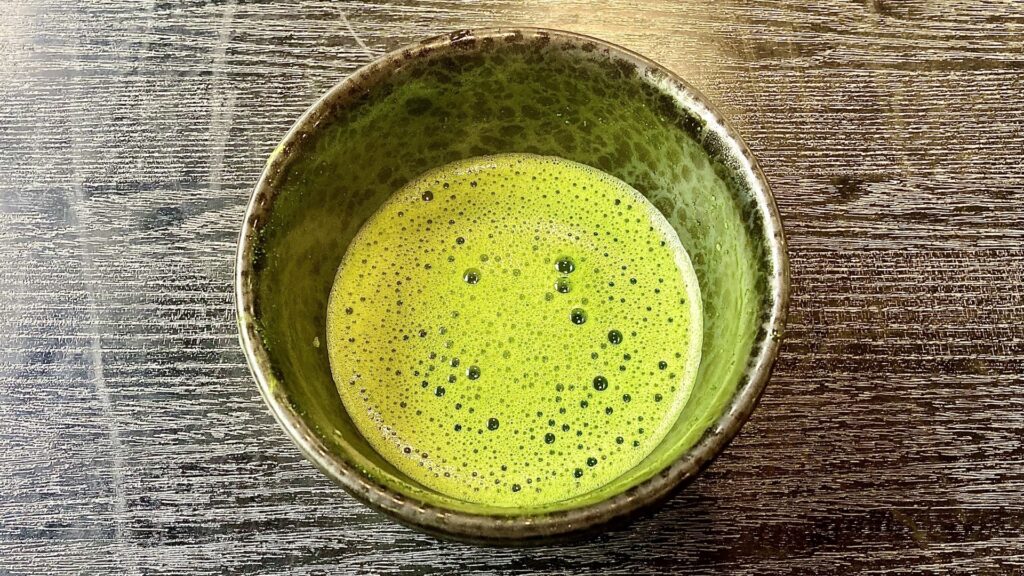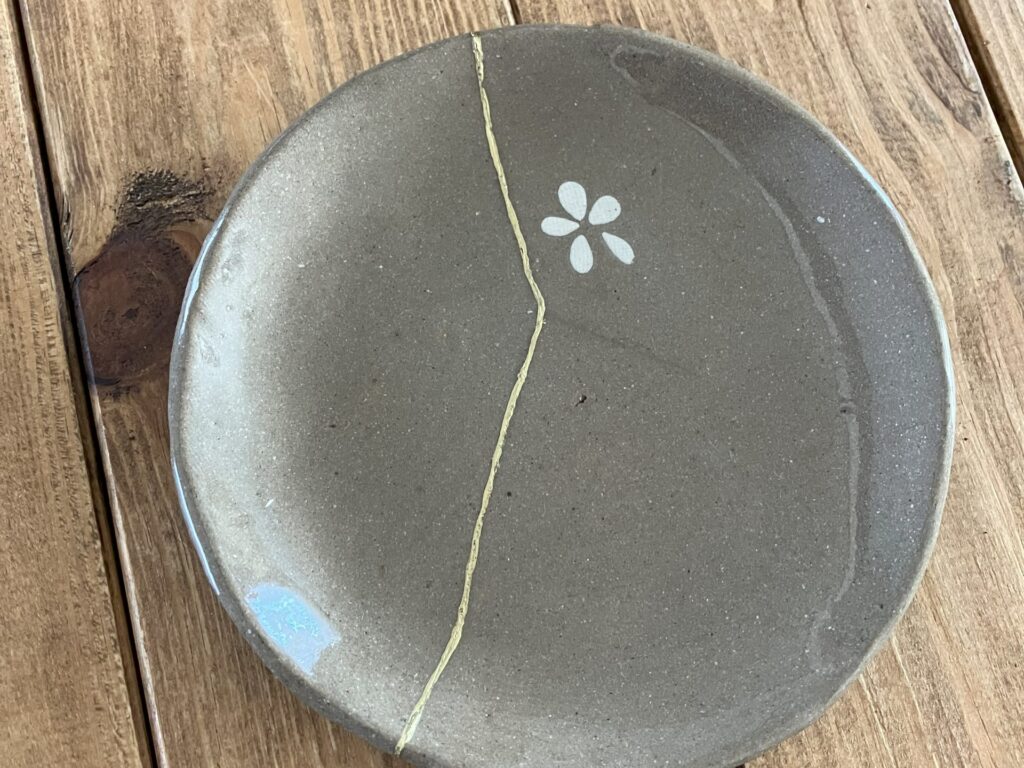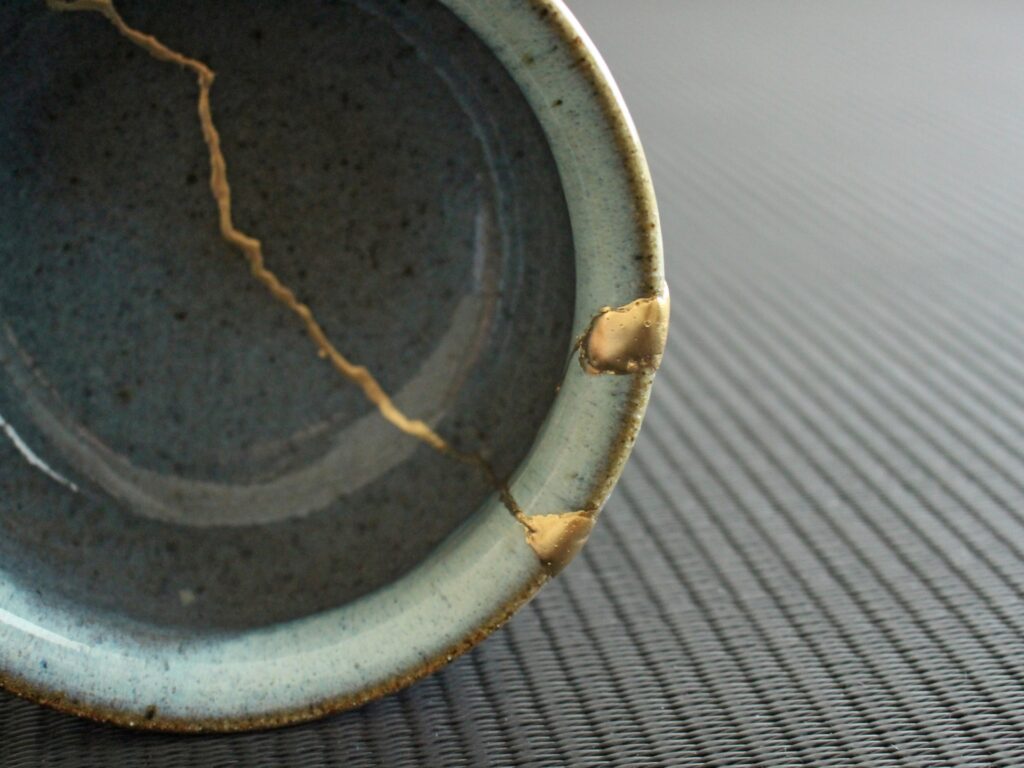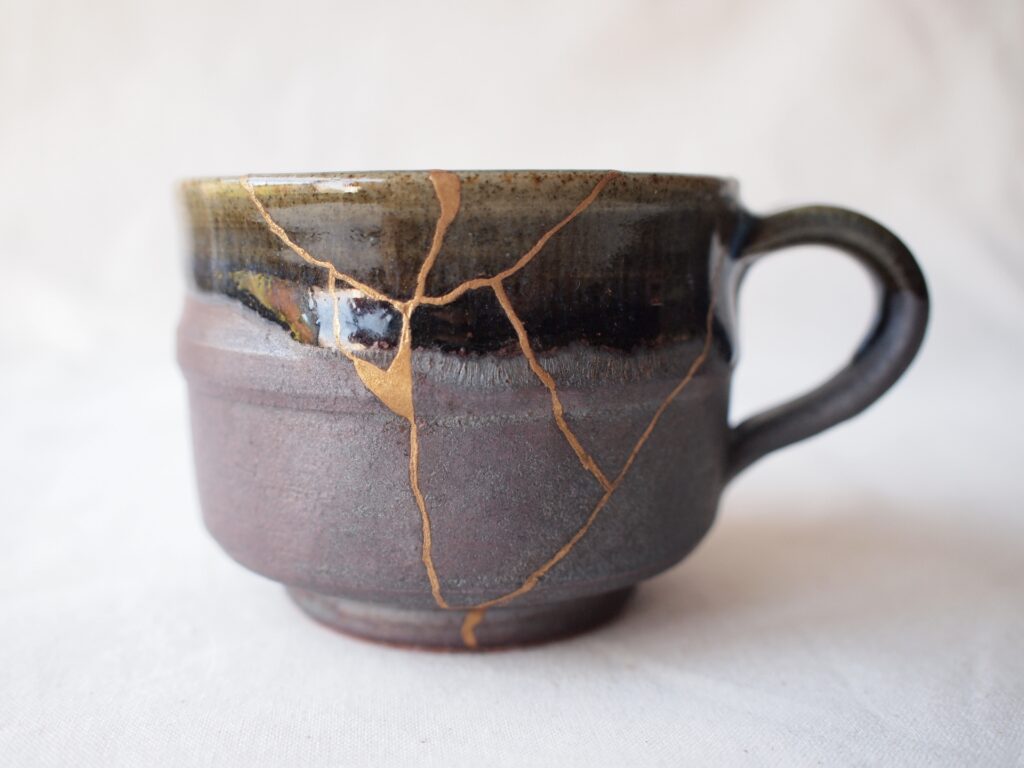Have you ever broken your favourite cup or plate and felt a little heartbroken? In Japan, instead of throwing such pieces away, there is a beautiful tradition of mending them, while also celebrating their history and imperfections. It’s called Kintsugi, or “golden joinery.” In this blog, let’s explore the world of Kintsugi: its meaning, deep cultural roots, unique materials, and how you can experience it for yourself in Japan.
What Is Kintsugi?
Kintsugi (金継ぎ) is the Japanese art of repairing broken pottery using lacquer mixed with gold, silver, or platinum powder. Rather than hiding the cracks, Kintsugi highlights them—transforming the once-damaged piece into something even more beautiful than before.
The word “Kintsugi” literally means “gold joinery,” and it’s also known by another name, “Kintsugui (金繕い)”, meaning “gold mending.” This traditional craft is used to repair ceramics, porcelain, and even lacquerware that have been cracked, chipped, or broken.
The process uses lacquer. The lacquer used for Kintsugi is a natural lacquer made from the sap of trees like the urushi tree (Toxicodendron vernicifluum) or the black tree, which grows mainly in East Asia. This sap has been used for over 9,000 years in Japan for coating, bonding, and protecting various objects—from bowls and boxes to furniture and artwork. When cured, this lacquer becomes safe for human use and forms a remarkably strong bond, earning it the nickname “nature’s super glue.”
Urushi is a versatile material. It can be used
- as a “paint” when applied as is(also can be used as a glue)
- as an “adhesive” when mixed with flour
- as a “putty” when mixed with wheat flour and wood powder
- as a “paste” when mixed with clay
But Kintsugi is not just about fixing things. It’s rooted in a deeper philosophy: treating the damage as part of the object’s history, not something to be hidden. Cracks and fractures are viewed as part of the vessel’s unique “landscape” (keishiki), and are decorated with precious metal powders. Through this method, each piece is not simply restored, but reborn with new life and character.
Interestingly, similar techniques can be traced all the way back to Japan’s Jomon period. Archaeological discoveries have revealed ancient pottery repaired with lacquer, indicating that the concept of mending broken items was already present in early Japanese culture. It’s a tradition deeply tied to how people in Japan have long valued resourcefulness, respect for objects, and continuity.
The History of Kintsugi
The origins of Kintsugi are wrapped in history and tradition, and while there are several theories, the commonly accepted view is that the technique we know today was developed during the Azuchi-Momoyama period (late 16th century) to the early Edo period (17th century). This era coincided with the flourishing of “chanoyu” (茶の湯)—the Japanese tea ceremony culture—and Kintsugi was born as part of that artistic and philosophical movement.
As tea culture grew in popularity, so did the appreciation for the aesthetic value of tea utensils. Even when cherished tea bowls or cups cracked or chipped, they were not discarded. Instead, they were repaired with care and reverence. This practical need gave rise to Kintsugi—a method of restoring broken pieces not just for reuse, but to honour their imperfections as part of their story.
What Is Chanoyu (Tea Ceremony)?

The tea ceremony, known as “chanoyu” or “sado,” was refined and perfected by the tea master Sen no Rikyu. His approach, called wabi-cha, emphasised simplicity, natural beauty, and the removal of all unnecessary luxury. This stripped-down aesthetic became a cornerstone of Japanese culture and deeply influenced the development of Kintsugi.
During this period, the tea ceremony was not only a spiritual and cultural practice but also a pastime of the elite—powerful warlords, wealthy merchants, and political leaders. For example, Oda Nobunaga, a famous daimyo of the Azuchi-Momoyama period, used the tea ceremony strategically in politics.
Nobunaga was an avid collector of rare tea utensils and famously restricted his retainers from freely hosting tea gatherings. Only those who had proven themselves through significant achievements on the battlefield were granted tea utensils and allowed to host a tea gathering. These items, received from Nobunaga himself, became symbols of honor, wealth, and power.
This prestige gave rise to a culture where tea utensils were treasured, repaired, and passed down for generations. Even broken pieces were too valuable to discard, leading naturally to the evolution and refinement of the Kintsugi technique.
In this way, Kintsugi is not just a practical repair method, but a practice born from a deep appreciation of beauty, imperfection, and the spiritual value of everyday objects.
Wabi-Sabi and the Spirit of Kintsugi
At the heart of Kintsugi is the traditional Japanese aesthetic of wabi-sabi, which embraces impermanence, imperfection, and the natural ageing process. Wabi-sabi teaches us to find peace and beauty in things that are humble and flawed.
Kintsugi reflects this spirit perfectly. The golden lines not only restore the vessel’s function but also honour its journey and transformation. A repaired cup or plate becomes one-of-a-kind, more valuable than before, not in a material sense, but in emotional and philosophical meaning.
Materials and Methods: How Kintsugi Works
There are several methods of Kintsugi, but traditional ones involve the use of urushi lacquer.
Here’s a simplified overview of the process:
- Cleaning and assembling the broken pieces.
- Bonding them together using urushi mixed with wheat flour.
- Once dried, the seams are coated with red lacquer.
- Metal powder (usually gold, silver, or brass) is carefully applied to the seams.
- Finally, the piece is polished and cured over several weeks.
Today, there are also simplified versions for beginners using synthetic adhesives, but traditional methods are still practised by artisans and in professional workshops.
👏The video is made by Kintsugi Library (@KintsugiLibrary).
The Charm of Kintsugi: Why It’s So Loved
In recent years, Kintsugi has captured the hearts of people around the world—not only as a repair technique, but as a powerful metaphor for life. Its unique charm lies in how it transforms damage into beauty and imperfection into something worth celebrating.
- 🌟 Turning flaws into beauty: The shimmering golden lines created by Kintsugi don’t try to hide the cracks—they highlight them. Each repaired piece becomes a work of art, marked by its past and made more beautiful because of it. It shows us that something broken can become even more valuable and meaningful than when it was whole.
- 🌍 Eco-friendly values: In a time when fast consumption and throwaway culture are common, Kintsugi offers a sustainable alternative. Instead of tossing out damaged items, it invites us to repair, reuse, and respect what we already have. This reflects a broader Japanese philosophy of mottainai, which expresses regret over waste and encourages mindful living.
- 🎨 One-of-a-kind artistry: No two Kintsugi repairs are ever the same. Each crack, chip, and seam tells its own unique story. The result is a one-of-a-kind object that reflects the hands and heart of the person who restored it. It becomes more than a functional item—it becomes a piece of personal and artistic expression.
- 💛 Emotional healing: For many people, Kintsugi resonates deeply on a personal level. It serves as a gentle reminder that wounds, both physical and emotional, are part of our journey and can lead to new strength and beauty. Some even see Kintsugi as a form of therapy, helping them process loss, trauma, or personal growth by embracing—not erasing—life’s cracks.
In a world often obsessed with perfection, Kintsugi offers a peaceful, poetic message: brokenness is not the end. It can be the beginning of a new story—one that is richer, deeper, and more meaningful. That message, perhaps more than anything, is why so many people around the world have fallen in love with this beautiful Japanese tradition.
Want to Try Kintsugi? Visit a Pottery Class in Japan
If you’re interested in experiencing Kintsugi yourself, the best way is to visit a pottery class in Japan. Many pottery studios offer Kintsugi workshops alongside regular pottery-making experiences.
Because traditional Kintsugi involves natural lacquer and a delicate process, it’s not easy to master on your own. But in a classroom setting, you can ask questions directly and learn from skilled instructors. This hands-on experience also helps you understand the care and patience behind the craft.
💡 Tips before you join a workshop:
- Some materials, such as glass and wooden items, are not suitable for Kintsugi, especially for beginners.
- Avoid using Kintsugi-repaired items in microwaves or dishwashers. The heat and moisture can damage the repaired areas.
- Vessels like pots and flower vases that retain heat or water may not be ideal for everyday use after repair.
Still, learning Kintsugi in Japan is a truly rewarding experience—and a meaningful way to connect with Japanese culture and values.
Ready to Begin Your Kintsugi Journey?
Whether you’re curious about Kintsugi’s deep roots in Japanese history or simply want to experience this beautiful art form firsthand, we’d love to help you get started.
Kintsugi Kits are sold if you like DIY works, or you are good at handicrafts and want to try Kintsugi by yourself. Feel free to reach out in the Contact Form, or by Messenger or email ([email protected]), if you’re planning a trip to Japan or want to know more about Kintsugi and pottery classes.
Let’s celebrate the beauty of imperfection together—one golden seam at a time.



